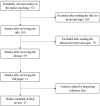The Construction and Validation of the Heat Vulnerability Index, a Review
- PMID: 26132476
- PMCID: PMC4515652
- DOI: 10.3390/ijerph120707220
The Construction and Validation of the Heat Vulnerability Index, a Review
Abstract
The occurrence of extreme heat and its adverse effects will be exacerbated with the trend of global warming. An increasing number of researchers have been working on aggregating multiple heat-related indicators to create composite indices for heat vulnerability assessments and have visualized the vulnerability through geographic information systems to provide references for reducing the adverse effects of extreme heat more effectively. This review includes 15 studies concerning heat vulnerability assessment. We have studied the indicators utilized and the methods adopted in these studies for the construction of the heat vulnerability index (HVI) and then further reviewed some of the studies that validated the HVI. We concluded that the HVI is useful for targeting the intervention of heat risk, and that heat-related health outcomes could be used to validate and optimize the HVI. In the future, more studies should be conducted to provide references for the selection of heat-related indicators and the determination of weight values of these indicators in the development of the HVI. Studies concerning the application of the HVI are also needed.
Keywords: extreme heat; heat vulnerability index; validation of HVI; vulnerability map.
Similar articles
-
Development of a heat vulnerability index for New York State.Public Health. 2018 Aug;161:127-137. doi: 10.1016/j.puhe.2017.09.006. Epub 2017 Dec 1. Public Health. 2018. PMID: 29195682
-
Heat Wave Vulnerability Mapping for India.Int J Environ Res Public Health. 2017 Mar 30;14(4):357. doi: 10.3390/ijerph14040357. Int J Environ Res Public Health. 2017. PMID: 28358338 Free PMC article.
-
Impact of extreme heat on health in Australia: a scoping review.BMC Public Health. 2025 Feb 7;25(1):522. doi: 10.1186/s12889-025-21677-9. BMC Public Health. 2025. PMID: 39920610 Free PMC article.
-
Predicting hospitalization for heat-related illness at the census-tract level: accuracy of a generic heat vulnerability index in Phoenix, Arizona (USA).Environ Health Perspect. 2015 Jun;123(6):606-12. doi: 10.1289/ehp.1307868. Epub 2015 Jan 30. Environ Health Perspect. 2015. PMID: 25635952 Free PMC article.
-
Climate change and extreme heat events.Am J Prev Med. 2008 Nov;35(5):429-35. doi: 10.1016/j.amepre.2008.08.021. Am J Prev Med. 2008. PMID: 18929969 Review.
Cited by
-
Appraisal of the heat vulnerability index in Punjab: a case study of spatial pattern for exposure, sensitivity, and adaptive capacity in megacity Lahore, Pakistan.Int J Biometeorol. 2019 Dec;63(12):1669-1682. doi: 10.1007/s00484-019-01784-0. Epub 2019 Aug 24. Int J Biometeorol. 2019. PMID: 31446482
-
Heat Adaptive Capacity: What Causes the Differences Between Residents of Xiamen Island and Other Areas?Front Public Health. 2022 Feb 21;10:799365. doi: 10.3389/fpubh.2022.799365. eCollection 2022. Front Public Health. 2022. PMID: 35265572 Free PMC article.
-
Inequality in the availability of residential air conditioning across 115 US metropolitan areas.PNAS Nexus. 2022 Sep 24;1(4):pgac210. doi: 10.1093/pnasnexus/pgac210. eCollection 2022 Sep. PNAS Nexus. 2022. PMID: 36714868 Free PMC article.
-
Vulnerability and Adaptation to Extreme Heat in Odisha, India: A Community Based Comparative Study.Int J Environ Res Public Health. 2019 Dec 12;16(24):5065. doi: 10.3390/ijerph16245065. Int J Environ Res Public Health. 2019. PMID: 31842287 Free PMC article.
-
Heat illness data strengthens vulnerability maps.BMC Public Health. 2021 Nov 3;21(1):1999. doi: 10.1186/s12889-021-12097-6. BMC Public Health. 2021. PMID: 34732187 Free PMC article.
References
-
- Sheridan S.C., Kalkstein L.S. Progress in heat watch-warning system technology. Bull. Amer. Meteorol. Soc. 2004;85:1931–1941. doi: 10.1175/BAMS-85-12-1931. - DOI
Publication types
MeSH terms
LinkOut - more resources
Full Text Sources
Other Literature Sources
Medical


